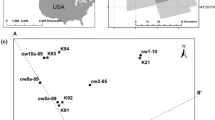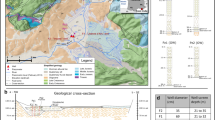Abstract
Aquifer coefficients derived from nonsteady-state, multiple well, aquifer tests in laterally heterogeneous environments often have uncertain meaning. Drawdown at observation wells reflects the removal of water from storage in the aquifer and transient refraction of ground water pathlines during the evolution of a non-symmetrical cone of depression. These effects are masked within observation well drawdown data such that “good” Theis (1935) type curve matches often result. Transmissivity and storativity values derived from independent drawdown curves plotted as drawdown versus time (t) or drawdown versus time/distance2 (t/r2) usually differ from observation well to observation well. These aquifer coefficients often are considered to represent some type of average of the materials between and/or about the pumping well and the observation wells. Simulations of two multiple well aquifer tests with simple, arbitrary distributions of block heterogeneities suggest that transmissivity (T) and storativity values derived from independent drawdown curves by the Theis (1935) method generally increase with distance from the pumping well. This apparent scale effect is related to the force-fitting of earlytime drawdown data to the steep portion of the Theis type curve without sufficient late-time drawdown data to constrain vertical shifting of the drawdown data relative to the type curve.
Log-log plots of drawdown versus t/r2 for multiple well aquifer tests form families of curves that are characteristic of the distribution of observation wells and the degree of heterogeneity within the cone of depression. Separation between discrete drawdown curves within a family provides a qualitative measure of the degree of heterogeneity within the cone of depression. All of the drawdown curves within a family converge on a single curve at large values of t/r2. A composite analysis of all of the drawdown data within the family yields an estimate of the average T within the cone of depression. Analysis of discrete drawdown curves as integral members of the family of curves provides a means to constrain type curve matches and minimizes force-fitting if drawdown data are defined for large values of t/r2 for at least one well. The constrained type curve matches provide more reasonable estimates for T near individual observation wells than analysis of drawdown curves independently.
Similar content being viewed by others
References
Barker, J.A. and R. Herbert, 1982. Pumping tests in patchy aquifers. Ground Water, 20(2): 150–155.
Bibby, R., 1977. Characteristics of pumping tests in heterogeneous clastic sediments, Edmonton, Alberta. Alberta Research Council Bulletin 35: 31–39.
Bibby, R., 1979. Estimating sustainable yield to a well in heterogeneous strata. Alberta Research Council Bulletin 37, Edmonton, 60 pp.
Butler, J.J., Jr., 1986. Pumping Tests in Non-uniform Aquifers: A Deterministic and Stochastic Analysis. Ph.D. dissertation, Stanford University, Stanford, CA., 230 pp.
Butler, J.J., Jr., 1988. Pumping tests in non-uniform aquifers—the radially symmetric case. J. Hydrol., 101(1/4): 15–30.
Butler, J.J., Jr., 1990. The role of pumping tests in site characterization: Some theoretical considerations. Ground Water, 28(3): 394–402.
Butler, J.J., Jr., 1991. A stochastic analysis of pumping tests in laterally non-uniform media. Water Resour. Res., 27(9): 2401–2414.
Butler, J.J., Jr., and J.M. Healey, 1998. Relationship between pumping-test and slug-test parameters: Scale effect or artifact? Ground Water, 36(2): 305–313.
Butler, J.J., Jr. and C.D. McElwee, 1990. Variable-rate pumping tests for radially symmetric non-uniform aquifers. Water Resour. Res., 26(2): 291–306.
Butler, J.J., Jr., and W. Liu, 1993. Pumping tests in non-uniform aquifers: The radially asymmetric case. Water Resour. Res., 29(2): 259–269.
Cardwell, W.T. and R.L. Parsons, 1945. Average permeabilities of heterogeneous oil sands. Trans. of A.I.M.E., 160: 34–42.
Cooper, H.H., Jr. and C.E. Jacob, 1946. A generalized graphical method for evaluating formation constants and summarizing well-field history. Eos Trans. AGU, 27(4): 526–534.
Davis, S.N. and R.J.M. DeWiest, 1966. Hydrogeology. John Wiley, New York, 463 pp.
de Marsily, G., 1986. Quantitative Hydrogeology, Groundwater Hydrology for Engineers. Academic Press, Orlando, FL.
Desbarats, A.J., 1987. Numerical estimation of effective permeability in sand-shale formations. Water Resour. Res., 23(2): 273–286.
Desbarats, A.J., 1992. Spatial averaging of transmissivity in heterogeneous fields with flow toward a well. Water Resour. Res., 28(3): 757–767.
Desbarats, A.J., 1993. Geostatistical analysis of interwell transmissivity in heterogeneous aquifers. Water Resour. Res., 29(4): 1239–1246.
Domenico, P.A., 1972. Concepts and Models in Groundwater Hydrology. McGraw-Hill, New York, 405 pp.
Domenico, P.A. and F.W. Schwartz, 1990. Physical and Chemical Hydrogeology. John Wiley, New York, 824 pp.
Duffield, G.M., 1996. AQTESOLV for Windows™. Developed by HydroSOLVE, Inc. Reston, Virginia, distributed by Geraghty & Miller, Inc., Millersville, Maryland.
Dykaar, B.B. and P.K. Kitanidis, 1992. Determination of the effective hydraulic conductivity for heterogeneous porous media using a numerical spectral approach, 2, Results. Water Resour. Res., 28(4): 1167–1178.
Dykaar, B.B. and P.K. Kitanidis, 1993. Transmissivity of a heterogeneous formation. Water Resour. Res., 29(4): 985–1001.
Freeze, R.A., 1975. A stochastic-conceptual analysis of one-dimensional groundwater flow in non-uniform homogeneous media. Water Resour. Res., 11(5): 725–741.
Golden Software Inc., 1995. SURFER® for Windows, Golden, CO.
McDonald, M.G. and A.W. Harbaugh, 1988. A modular three-dimensional finite-difference ground water flow model. Book 6, Techniques of Water Resources Investigations of the US Geol. Survey.
McElwee, C.D. and M.A. Yukler, 1978. Sensitivity of groundwater models with respect to variations in transmissivity and storage. Water Resour. Res., 14(3): 451–459.
Meier, P.M., J. Carrera and X. Sanchez-Vila, 1998. An evaluation of Jacob’s method for the interpretation of pumping tests in heterogeneous formations. Water Resour. Res., 34(5): 1011–1025.
Naff, R.L., 1991. Radial flow in heterogeneous porous media: an analysis of specific discharge. Water Resour. Res., 27(3): 307–316.
Oliver, D.S., 1993. The influence of non-uniform transmissivity and storativity on drawdown. Water Resour. Res., 29(1): 169–178.
Osiensky, J.L. and R.E. Williams, 1997. Potential inaccuracies in MODFLOW simulations involving the SIP and SSOR methods for matrix solution. Ground Water, 35(2): 229–232.
Rovey, C.W., II and D.S. Cherkauer, 1995. Scale dependency of hydraulic conductivity measurements. Ground Water, 33(5): 769–780.
Schad, H. and G. Teutsch, 1994. Effects of the investigation scale on pumping test results in heterogeneous porous aquifers. J. Hydrol., 159(1994): 61–77.
Serrano, S.E., 1997. The Theis Solution in Heterogeneous Aquifers. Ground Water, 35(3): 463–467.
Streltsova, T.D., 1988. Well Testing in Heterogeneous Formations. John Wiley, New York, 413 pp.
Theis, C.V., 1935. The relation between the lowering of the piezometric surface and the rate and duration of discharge of a well using groundwater storage. Eos Trans. AGU, 16: 519–524.
Theis, C.V., 1940. The source of water derived from wells—Essential factors controlling the response of an aquifer to development. Civil Eng., Amer. Soc. Civil Engrs., 277–280.
Toth, J., 1966. Groundwater, geology, movement, chemistry and resources, near Olds, Alberta. Research Council of Alberta Bulletin 17, Edmonton, 126 pp.
Vandenberg, A., 1977. Pump testing in heterogeneous aquifers. J. Hydrol., 34: 45–62.
Warren, J.E. and H.S. Price, 1961. Flow in heterogeneous porous media. Soc. Pet. Eng. J., 1(3): 153–169.
Waterloo Hydrogeologic, Inc., Visual Modflow. Developed by Nilson Guiguer and Thomas Franz, Waterloo, Ontario, Canada.
Waterloo Hydrogeologic, Inc., AquiferTest. Co-developed by Thomas Rohrich and Waterloo Hydrogeologic, Inc. Waterloo, Ontario, Canada.
Author information
Authors and Affiliations
Rights and permissions
About this article
Cite this article
Osiensky, J.L., Williams, R.E., Williams, B. et al. Evaluation of drawdown curves derived from multiple well aquifer tests in heterogeneous environments. Mine Water and the Environment 19, 30–55 (2000). https://doi.org/10.1007/BF02687263
Issue Date:
DOI: https://doi.org/10.1007/BF02687263




